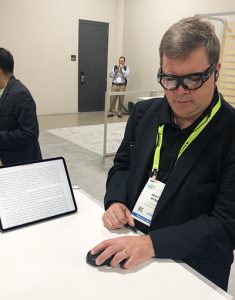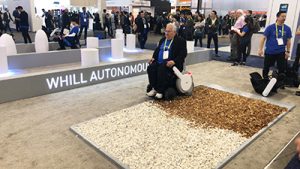This was year four for me at the annual CES in Las Vegas — the last three I participated in the Consumer Technology Association’s (CTA’s) Accessibility Leaders Group. CTA puts on CES each year. They invite people with disabilities to look at technology that could benefit people with disabilities and also talk with companies about accessibility and what it means. I participate in the low vision and blind group.
Each year the show has a main attraction; I would say that this year’s was “everything connected.” Everywhere you looked you would see a device that you could control with “Hey Google,” “Alexa,” or “Hey Siri.” Everything from controlling your shower, having a faucet measure you a cup of water, a litter box that cleans itself and tells you how many times your cat uses it, (of course) turning on the lights, opening the garage, a smart toilet (don’t ask) … and the list goes on.
I definitely see how this kind of technology can benefit me but at the same time wonder if some of it is overkill. (This would be different for someone with other disabilities.) I also want to wait to see if this kind of technology becomes available in standard consumer versions or only the high-end versions that the average consumer cannot afford. For example, a connected faucet may cost $1,500.
The great thing about CES is that CTA provides readers for the blind and interpreters for deaf and hard of hearing. It would be impossible to do the show without this great service provided by CTA.

Eureka Park
Eureka Park is the area for startups. It is also the Wild West. Most booths are 8 by 8. The aisles are eight feet wide and you can barely move. In Eureka Park you will find many things that will never make it to market; I saw several things that could be interesting for people with visual impairments:
- The first was Norm Smart Glasses, sunglasses with built-in audio allowing the end-user to listen to their phone. Additionally, these are Smart Glasses, so they do a lot more. The question will be if the rest of the features become accessible.
- The second product was a single cell Braille display mouse called Bonocle. You could move the mouse–which is connected to an iPad–and as you moved it across text, the characters were displayed one character at a time. The device also provided haptic feedback when you moved.
- Another product that I found interesting in Eureka Park was an in-ear foreign language translator called WT2 Plus. This was not specific to the blind, but very cool technology. It was amazing to have a real-time conversation with someone speaking Chinese.
- Finally, we saw some headphones called nuraphone that calibrated to your hearing.

Accessibility Category
CES has an accessibility section of the exhibits where you will find Vispero, American Printing House (APH), Whill Inc., etc. Not all companies in this section focus on accessibility and it is hard to find companies that do. The CES app has companies listed by the categories chosen by each vendor. Vendors can mark up to five categories and many mark ones that don’t apply to them. This year CES had over 150 companies that self-identified as part of the accessibility category and I can guarantee there were not 150 companies that focused on accessibility.
- Vispero was showing products from each of the brands: Freedom Scientific, Optelec, Enhanced Vision, and TPGi
- APH had two Braille products, the Graphiti and the Canute.
- Whill Inc., winner of the 2016 CES accessibility contest was showing off a power wheelchair that could go off road. This is very cool.
Other Cool Things
AfterShockz, a company that is very popular with people who are blind, was demoing sunglasses with built-in bone conducting headphones.
Another company designing headphones was Beyerdynamic. They had a unique feature: they were flat on the outside so that you could wear them to bed without poking your ear. One model is the Soul BYRD. The high-end Bluetooth model had a feature that would calibrate to your hearing.
I saw several booths focused on headphones that assisted the user to focus on specific sounds like a conversation in a loud area or watching TV. One is NuHeara.
I really love the idea of a self-driving suitcase. Try walking with a cane, drinking tea, and pulling a suitcase in an airport. Forward X Robotics has solved my problem with a smart suitcase that follows you.
Some other devices for the blind were WeWalk Smart Cane, an object detection device called Strap from Mexico and OrCam’s MyMe which would identify the person you were talking to using facial recognition and social media profiles (watch out privacy).
Other Thoughts
Something else that I noticed was the prevalence of VR. It showed up in gaming, movie watching, training, etc.– there was VR everywhere. I tried out several of these and none of them were accessible to me. None of the VR products I looked at supported screen reading or focus identification. When you discuss this with the vendors, they look at you and say “Why would a blind person use VR?”
The show had an entire section devoted to self-driving vehicles. Not all are designed to transport people. Some were for transporting products. One could even deliver pizza or ice cream.
Smart desks that will allow you to sit or stand, charge your phone, give you three monitors and allow you to ride a bike while working. I say take some time to ride the bike away from work. 🙂
Healthcare
Smart Health is everywhere, and things you don’t think of as healthcare will show up as Smart Health. One of the things I saw a lot was companies creating watches that monitored your health and would share data to doctors and care givers. Some companies are even trying to measure blood pressure. One confusing aspect of these products is where they fit: is it Smart Health or wearable technology?
Finally
If you plan to go to CES and you have a vision or hearing loss I recommend that you reach out to CTA prior to the show. I also recommend taking it slow; there is a lot to see and it is spread out over several locations. Also, make sure you wear comfortable shoes.
Comments
Fantastic post. Thanks so much for sharing your experience.
Loved your live broadcast of CES using Aira.